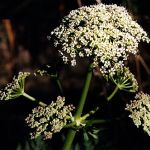| Common Name: |
Oshá |
| Other Names: |
Porter's lovage, Colorado cough root, bear root |
| Botanical Name: |
Ligusticum porteri |
| Genus: |
Ligusticum |
| Family: |
Apiaceae |
| Native Locations: |
Southern Rocky Mountains |
| Cultivation: |
Well-drained to dry soil in sun. Ligusticum sinense tolerats damp conditions. Ligusticum porteri is challenging to cultivate at low elevations. |
| Propagation: |
By seed sown in spring: by division in autumn. |
| Harvest: |
Leaves and stems (L. scoticum) are cut in spring for use as a vegetable and at any time as a flavoring. Roots are lifted in autumn and used fresh or dried for oil extraction. (L. porteri), decoctions and tinctures. Seeds are collected when ripe and ground (L. scoticum) or distilled for oil (L. porteri). Roots are lifted in autumn and dried for decoctions (L. sinense). |
| Height: |
45-90cm (18-36in) |
| Width: |
60cm (24in) |
| Hardiness: |
Z3 |
| Parts Used: |
Roots, seeds, oil. |
| Properties: |
A bitter, camphoraceous, warming herb that stimulates the circulation, kidneys, and uterus; it improved digestion, relieves spasms, is expectorant, and increases perspiration. Anti-bacterial and anti-viral effects are reported. |
| Medicinal Uses: |
Internally for eruptive fevers, virus infections, bronchial and digestive complaints, coughs, toothache, painful menstruation, and retained placenta. Externally for minor injuries and skin infections. |
| Culinary Uses: |
Dried leaves and seeds, have a flavor reminiscent to celery, parsley, and chervil. |
| Bibliography: |
Encyclopedia of Herbs by Deni Brown Copyright © 1995, 2001 Dorling Kindersley Limited. pp 260-261 |

